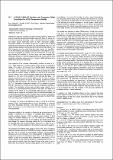A 120nW 18.5kHz RC oscillator with comparator offset cancellation for ±0.25% temperature stability
Author(s)
Paidimarri, Arun; Griffith, Danielle; Wang, Alice; Chandrakasan, Anantha P.; Burra, Gangadhar
DownloadMy own formatted final version of the paper (399.4Kb)
OPEN_ACCESS_POLICY
Open Access Policy
Creative Commons Attribution-Noncommercial-Share Alike
Terms of use
Metadata
Show full item recordAbstract
Integrated low-frequency oscillators can replace crystal oscillators as sleep-mode timers to reduce the size and cost of wireless sensors [1]. Since the timer is one of the few continuously functioning circuits, minimizing its power consumption can greatly reduce sleep-mode power of highly duty-cycled systems. Temperature stability of the oscillator is important in order to minimize timing uncertainly and guard time for the radios, and thus maximizing sleep time. The voltage-averaging feedback method described in [2] achieves high stability in the MHz frequencies, but when scaled to the kHz range, requires very large filters. On the other extreme, gate leakage-based timers have been designed for sub-nW power consumption, but operate in the sub-Hz frequencies [3]. In the past, high accuracy RC oscillators in the kHz range have been designed with feed-forward correction [1] and self-chopped operation [4]. In this work, an offset cancellation architecture achieves long-term frequency stability and temperature stability while operating at lower power.
Date issued
2013-02Department
Massachusetts Institute of Technology. Department of Electrical Engineering and Computer ScienceJournal
Proceedings of the 2013 IEEE International Solid-State Circuits Conference Digest of Technical Papers
Publisher
Institute of Electrical and Electronics Engineers (IEEE)
Citation
Paidimarri, A., D. Griffith, A. Wang, A. P. Chandrakasan, and G. Burra. “A 120nW 18.5kHz RC Oscillator with Comparator Offset Cancellation for ±0.25% Temperature Stability.” 2013 IEEE International Solid-State Circuits Conference Digest of Technical Papers (February 2013).
Version: Author's final manuscript
ISBN
978-1-4673-4516-3
978-1-4673-4515-6
978-1-4673-4514-9